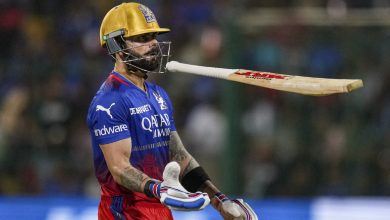From wrestling hubs of Maharashtra to Delhi’s Chhatrasal in search of an Olympic berth | Sport-others News

Pruthviraj Mohol is a fourth generation wrestler from Mulshi taluka of Pune, and his grandfather was Maharashtra Kesari. Soon after his first School Nationals, however, his father, an accomplished wrestler himself, started preparing him for a move to Delhi.“We could see after I won U17s that Mahabali Satpal was India’s greatest coach because India’s top medals at Olympics were coming from his trainees. So I gave trials for Chhatrasal and moved,” Mohol, who picked the 125kg gold at the suspended WFI’s Pune Nationals, said.
The field might have been depleted in Pune and Jaipur will have the original crowning, but Mohol inss that Olympics are his ultimate goal.
After years of hosting top wrestlers from north India at renowned talims (akhadas) in Kolhapur, Sangli, Satara and Pune, a reverse journey is underway. Maharashtra wrestlers are increasingly considering moving to north India’s most competitive training facility, Chhatrasal stadium, to get a move on their stagnant careers.
After Rahul Aware honed his talent at Sonepat, the two heavyweight Pruthvirajs — Khadke, the Greco Roman 97 kg grappler, and Mohol, the 125 kg strongman, took the decision to move to wrestling’s monastery-like campus of Chhatrasal to take forward their careers. “Rahul Aware fought in the same weight category for over 10 years. He’s an inspiration, and we realised training with the best was important,” Mohol says.
The Delhi-based Maharashtra pehelwans are clear the writing was on the mud pits, and no number of Kesari titles could quite compare with Olympic success on the shiny blue & mustard mats.
“We had to go, and it’s been considered for 2-3 years,” says Khadke, adding that while his junior national and Khelo India bronze from 2022-23 for Maharashtra guaranteed him due attention in his home state, the future didn’t look great.
“At Chhatrasal, there’s no time-pass. They train with dreams of the Olympics only. The focus never wavers. We don’t want to be left behind merely fighting in jatraa kustis (mud village fair dangals), where most Maharashtra pehelwaans are steered towards,” says the 22-year-old.
Khadke grew up on a staple diet of watching Haryana and Delhi wrestlers win, and simply went and found out for himself why they won. “In Maharashtra, mud wrestling is a huge draction, for fame and money. In Chhatrasal, the focus is only on getting better at the game, mind is only on Olympics wrestling,” he says.
He’s not too thrilled with the support from Maharashtra governments of the past two decades either. “There’s no support in terms of jobs and facilities are not geared towards mat wrestling,” he says.
Maharashtra wrestlers spent years living off the legacy of past greats from more than 30 years ago, without achieving much themselves. The state might’ve given India its first Olympic medall in 1952, but even Asian Games medals have dried up in recent decades as the state totters towards irrelevance in the sport.
For years now, wrestlers from the erstwhile powerhouse had been telling themselves that they received a rough deal from wrestlers, coaches and referees of the north in selection trials and national competitions. Except, a new generation of wrestlers now is refusing to misdiagnose their failures and taking charge of their futures.
A Kolhapur wrestling coach continues to brew bitter resentment, and Mohol says he believed the same and there was some truth in it. The predominantly women’s coach explains, “Wrestlers from Maharashtra, Karnataka, MP were always on the backfoot when fighting Haryana wrestlers. We could see unfairness with our own eyes, when a point was earned our wrestlers, but not awarded,” the coach explains.
This age-old resentment — partly legitimate — has shaped much of the alignments of the last two years in the federation politics, and explains why the wrestlers’ protests didn’t get unanimous support.Mohol who’s braved three Delhi winters now, explains, “Yes I grew up hearing about partiality towards north wrestlers, and even experienced it. But after shifting to Chhatrasal I didn’t face any hostility. I slowly made friends and realised their dominance is largely due to their mat skills. There might be some partiality, but now that I’m friends with north side referees, they are fair to me now. They see me as one of them,” he says.
Mohol was an ace at the 127-year-old Khalkar Talim in Pune’s Sadashiv Peth, steeped in tradition, as a junior.
“But there was no doubt I’d head to Mahabali Satpal if I wanted to progress after 17s Nationals. The food was very different and I’d fall ill often. But my father kept telling me it’s part of tapasya (struggle). Slowly, I made friends and adjusted to the food and cold winters too,” he says.
The 125kg needs a lot of protein, and he went hungry. “See, us Maharashtra wrestlers, especially heavyweights, need non veg and mutton if we have to stay strong. The Delhi, Haryana wrestlers are vegetarian and for their body weights it’s OK. But I did struggle with food. It’s OK,” he says.
He even picked the Haryanvi drawl of speaking, though he suspects like most Marathis in Delhi, he properly mutilated the Hindi unwittingly. “I’ve learnt to speak like them. But whenever I joke using their language, they just fall silent. They also need to respond, for the joke to land? They tell me instead to teach them Marathi.They’ve learnt quite a few words,” he says. And he’s picked the skills that matter and need no linguic expertise.







